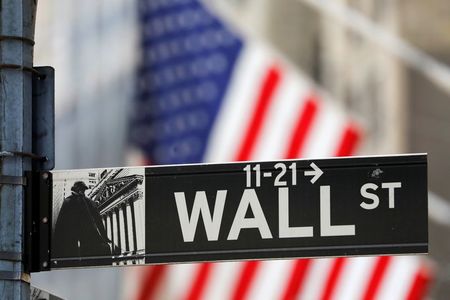By Stephen Culp
NEW YORK (Reuters) – Big tech helped Wall Street inch up to a higher close on Thursday, modestly building on a two-day rally as lackluster economic data and mixed corporate earnings prompted a pivot back to growth stocks.
A pull-back in economically sensitive cyclicals kept the S&P 500’s and the blue-chip Dow’s gains muted, while small-caps underperformed their larger rivals.
But megacap tech and tech-adjacent stocks, such as Microsoft Corp, Amazon.com, Apple Inc, Facebook Inc and Alphabet Inc, rose ahead of their quarterly results next week, putting the Nasdaq out front.
All three major U.S. stock indexes ended the session within 1% of their record closing highs.
Growth stocks, which outperformed throughout the health crisis, were back in favor, gaining 0.8%, while the value index slipped by 0.5%.
“The market is flip-flopping between the view that economic growth has almost peaked so you need to buy stocks that manufacture their own growth like tech names, versus the view that economic growth will continue and you want to own cyclicals and value names,” said David Carter, chief investment officer at Lenox Wealth Advisors in New York.
The number of U.S. workers filing first-time applications for unemployment benefits spiked unexpectedly to 419,000 last week, a two-month high, according to the Labor Department.
Market participants are closely watching labor market indicators for hints as to when the Federal Reserve, expected to convene next week for its two-day monetary policy meeting, will begin discussions about hiking key interest rates from near zero.
“The jobless data today didn’t have a meaningful impact on markets or the economic outlook,” Carter added. “It’s now all about how much longer the Fed will tolerate low rates. The Fed seems to be favoring its full employment mandate more than its price stability mandate.”
“Accordingly, the upcoming Fed meeting could be impactful,” Carter said.
Benchmark Treasury yields eased after the bid at the largest-ever TIPS auction touched a record low, pressuring rate sensitive banks.
The Dow Jones Industrial Average rose 25.35 points, or 0.07%, to 34,823.35, the S&P 500 gained 8.79 points, or 0.20%, to 4,367.48 and the Nasdaq Composite added 52.64 points, or 0.36%, to 14,684.60.
Of the 11 major sectors of the S&P 500, tech was shining brightest, gaining 0.7%. Energy stocks suffered the largest percentage drop.
The second-quarter reporting season barreled ahead at full-throttle, with 104 of the companies in the S&P 500 having reported. Of those, 88% have beaten consensus estimates, according to Refinitiv.
Drugmaker Biogen Inc gained 1.1% after hiking its full-year revenue guidance, while Domino’s Pizza Inc surged 14.6% to an all-time high on the heels of its quarterly report.
Southwest Airlines Co posted a bigger-than-expected quarterly loss, sending its stock down 3.5%, and American Airlines Group Inc dipped 1.1% even after reporting a quarterly profit.
The S&P 1500 Airlines index ended the session off 1.7%.
Shares of Texas Instruments Inc slid 5.3% after its current-quarter revenue forecast cast concerns as to whether the company will be able to meet spiking demand in the face of a global semiconductor shortage.
The Philadelphia SE Semiconductor index ended the session down 0.9%.
Chipmaker Intel Corp slipped more than 1% in extended trading after the chipmaker posted results and raised its annual revenue forecast.
Declining issues outnumbered advancing ones on the NYSE by a 1.82-to-1 ratio; on Nasdaq, a 1.90-to-1 ratio favored decliners.
The S&P 500 posted 39 new 52-week highs and no new lows; the Nasdaq Composite recorded 70 new highs and 54 new lows.
Volume on U.S. exchanges was 8.25 billion shares, compared with the 10.12 billion average over the last 20 trading days.
(Reporting by Stephen Culp”; Additonal reporting by Devik Jain and Shreyashi Sanyal in Bengaluru; Editing by Marguerita Choy)





